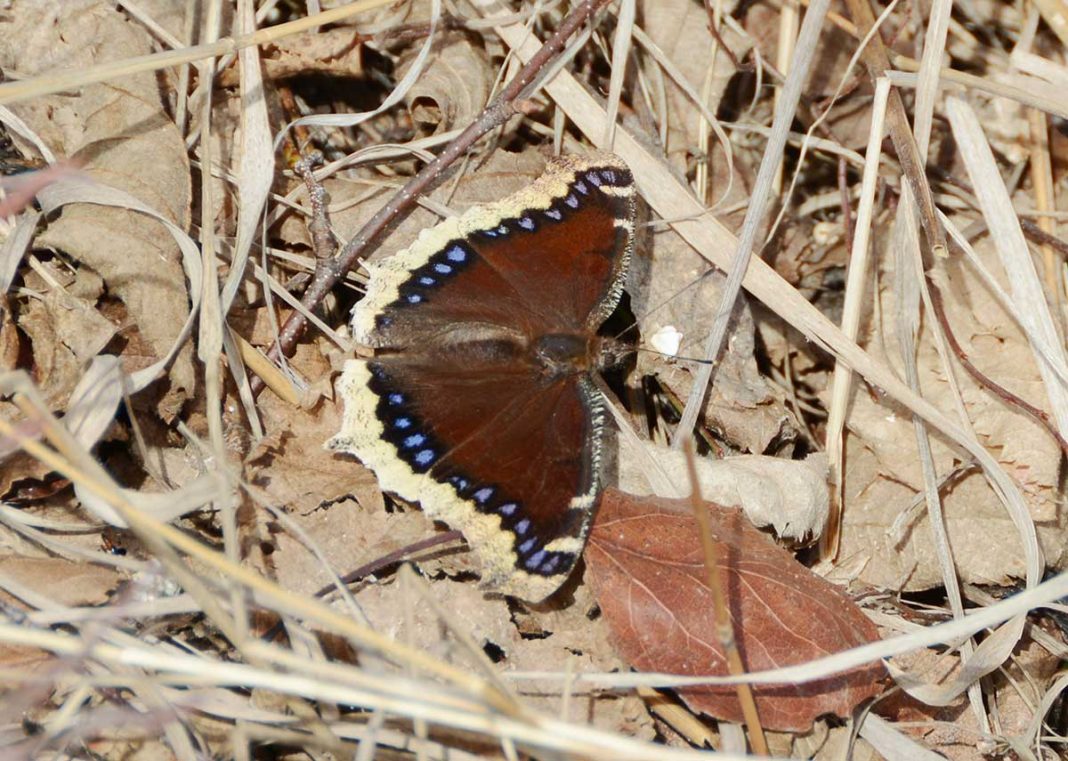by Joe Shorthouse
MANITOULIN – Perhaps more than any time in recent history, residents of Manitoulin could do with a connection to nature. We all need relief from worrisome news brought on by the COVID-19 virus, and luckily the back yards and trails on Manitoulin provide a plethora of opportunity if we look carefully.
For example, when venturing outside for a walk, look for mourning cloak butterflies casually flitting over the ground. We usually don’t associate butterflies with early spring before the appearance of flowers, but the mourning cloak is different with an unusual life cycle.
Mourning cloaks are a true harbinger of spring commonly seen even when there is still snow on the ground. When the temperature is 4°C or warmer, they fly around often landing on the ground or a tree.
The mourning cloak butterfly, with the scientific name Nymphalis antiopa, gets its common name from a resemblance to cloaks worn in years past when people were “in mourning.”
Mourning cloaks are large butterflies with a wing span of six to eight centimetres. The upper side of both male and female wings are dark maroon with ragged pale-yellow edges. Bright, iridescent blue spots line the black patches between the maroon and the yellow.
The underside has gray striations with the same pale-yellow edges. When their wings are folded back, they are camouflaged against the dark backdrop of tree trunks or the ground.
If you get close to a resting mourning cloak, you will notice they appear to have only four legs, contrary to the usual six for insects. They have six legs, but the first pair is greatly reduced often appearing as hairy brushes, resulting in another common name ‘brush-footed butterflies.’
There are many features of mourning cloaks that make them different from other butterflies. Most of our butterflies pass the winter either as an egg, partially-grown caterpillar or a chrysalis, but not the mourning cloak. Mourning cloaks overwinter in the adult stage and awaken when Manitoulin starts to warm up in the spring.
Most butterflies feed exclusively in the spring and summer on nectar they suck from flowers, but not mourning cloaks. This butterfly gets its carbohydrate energy from sap leaking from the trunks of maple and birch trees.
We normally associate butterflies with warm spring and summer days with temperatures above 15°C which begs the question: how do cold-blooded insects such as mourning cloaks manage to fly in early spring when their body temperatures must be as high as our own (37°C).
They do this by basking, a type of behaviour where they rest on the ground or on tree trunks and angle their bodies towards the sun. This causes their body temperature to rise higher than the air temperature.
Once they start flying, flight muscles generate more heat to keep them going. When the temperature drops, or clouds block the sun, they quickly seek shelter.
However, the most amazing feature of mourning cloaks is that the adults live for about 10 months. Most other kinds of butterflies live for only a few weeks, but mourning cloaks are long lived because they overwinter in the adult stage.
Come fall, adults enter nooks and crannies under logs or loose tree bark. They can even spend the winter in unheated sheds. Such sites, called a hibernacula (an overwintering den), protect them from winter winds, birds and squirrels.
Their bodies are frozen solid in the hibernacula and yet miraculously, they revive themselves in early spring when air temperatures rise above freezing.
The life cycle of mourning cloaks is also bizarre. Males emerging from hibernacula fly around looking for females. Males even practice lekking which we usually associate with mating behaviour in birds such as grouse.
Butterfly lekking, as with birds, is a territorial behaviour where males settle in one area and chase away other males that come near. Choice locations include sunny perches near margins of wooded areas and ponds where males can perch and defend the area.
Females mated in early spring must busy themselves for several weeks until leaves of their host plants appear. They lay several batches of eggs on branches of willow, aspen poplar or white birch, just as the new leaves are unfurling. Females die after laying eggs as do the males after mating with several females.
Freshly hatched caterpillars are black and spiny with red dots. Bodies are coved with stiff bristles which deters predators.
Like all caterpillars, they eat voraciously and grow rapidly. Full grown caterpillars are about six centimetres in length. Curiously, they feed gregariously, always within a few centimetres of their siblings. If disturbed, they shake and vibrate in unison which frightens predators.
If they eat all leaves on a small tree or shrub, they march off together in a follow-the-leader fashion in search of greener pastures.
Caterpillars feed until June, turn into a chrysalis and then in July a new generation of adults appears. Unlike most other species of butterflies, mourning cloaks that emerge from their chrysalis in mid-summer enter a state of dormancy until autumn, at which time they resume feeding to fatten up before hibernation.
Most of us have been drawn to butterflies since our childhood thanks to their magical flight patterns, beauty and grace. Perhaps more than any other critter, they provide us with a sense of calm, serenity and joy and make us look at life in a lighter way.
We often enter a kind of trance when watching butterflies. Perhaps it is Mother Nature sending us the message that no matter what changes occur in our future, and problems brought on by COVID-19 virus, there will be beauty at some point, just like the metamorphosis of a butterfly.
Dr. Joe Shorthouse is a retired professor of entomology at Laurentian University in Sudbury and a summer resident of Manitoulin Island.






